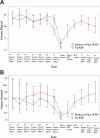Factors Affecting Return to Play After Primary Achilles Tendon Tear: A Cohort of NFL Players
- PMID: 30886876
- PMCID: PMC6415485
- DOI: 10.1177/2325967119830139
Factors Affecting Return to Play After Primary Achilles Tendon Tear: A Cohort of NFL Players
Abstract
Background: Achilles tendon tears are potentially career-ending injuries for professional athletes. For players in the National Football League (NFL), return requires not only surgery and extensive rehabilitation but also the ability to compete in a market with limited positions that annually introduces new recruits.
Purpose/hypothesis: We authors sought to evaluate factors related to return to play (RTP) and changes in performance following a primary Achilles tear. Our hypothesis was that "skilled" position players and those drafted in later rounds would return at a lower rate as compared with "unskilled" position players and higher draft-round players.
Study design: Case-control study; Level of evidence, 3.
Methods: From a previously established database, 80 NFL players were identified as having primary Achilles tendon tears between the 2009 and 2014 seasons. RTP was defined as playing in a regular season or postseason game following injury. Probability of RTP was modeled as a function of time after injury in Kaplan-Meier analysis with demographic variables assessed via generalized linear models. Twelve players (15%) experienced a subsequent Achilles tendon tear during or after the study period and were included in the overall RTP rate but were excluded from performance analyses owing to the confounding effects of an ipsilateral retear or contralateral tear.
Results: The overall RTP rate was 61.3%. Age, number of prior seasons, position type, or draft round status did not significantly affect RTP when evaluated with Kaplan-Meier analysis. In the season before their injury, players who did RTP played in a significantly greater number of regular season games (13.7) compared with players who did not RTP (8.71) (P = .011). Players who did not RTP exhibited a significant decrease in performance in the season preceding injury (12.7 regular season games played 2 seasons preinjury vs 8.71 regular season games played 1 season prior preinjury;, P = .019). Players who returned did not display a significant change in the number of games played or started in seasons following injury when >1 season after return was evaluated.
Conclusion: Rate of RTP following primary Achilles tendon tears may be lower than previously published. However, for those able to return, performance only in the season immediately following injury appears to be affected; players return to preinjury levels if given the opportunity to play >1 season after injury.
Keywords: Achilles tendon; ankle; football (American); ligaments; physical therapy/rehabilitation.
Conflict of interest statement
One or more of the authors has declared the following potential conflict of interest or source of funding: J.D.H. has received consulting fees from DePuy-Synthes Learning Institute (Medical Device Business Services). B.D.O. has received consulting fees from ConMed Linvatec, DePuy Synthes, Musculoskeletal Transplant Foundation, and Rotation Medical; honoraria from Musculoskeletal Transplant Foundation and Verical; and speaking fees from DePuy and Sanofi-Aventis. AOSSM checks author disclosures against the Open Payments Database (OPD). AOSSM has not conducted an independent investigation on the OPD and disclaims any liability or responsibility relating thereto.
Figures


References
-
- Ahmad J, Repka M, Raikin SM. Treatment of myotendinous Achilles ruptures. Foot Ankle Int. 2013;34(8):1074–1078. - PubMed
-
- Almekinders LC, Garrett WE, Wilson FC. Sports injuries. Curr Probl Surg. 2000;37(5):321–383.
-
- Amin NH, Old AB, Tabb LP, Garg R, Toossi N, Cerynik DL. Performance outcomes after repair of complete Achilles tendon ruptures in National Basketball Association players. Am J Sports Med. 2013;41(8):1864–1868. - PubMed
-
- Arthur R. The shrinking shelf life of NFL players. The Wall Street Journal. February 29, 2016.
LinkOut - more resources
Full Text Sources

